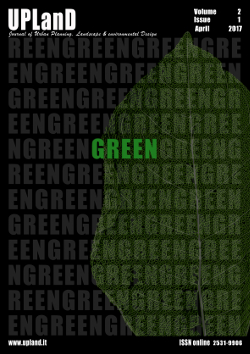Minor centres through identity and green development. The study case of Aquilonia
Main Article Content
Abstract
It’s been a long time since the EU strategy has focused on building and urban regeneration as a priority for environmental, social and economical development policies in member countries. The Municipality of Aquilonia (AV) commissioned a research project, in order to carry out a Specialized Study meant as a support for the municipal programme for building energetic efficiency and the improvement of power plants by means of renewable resources. In this frame some issues, dealing with the relationship between the general environmental topic and the peculiarities of some land and urban cases – especially minor urban centres – have been emphasized. With respect to the specific features, it has been underlined the risk to award the technological innovation the role of an uncritical acceptance of the use of new technologies, which actually fully satisfy the present demand of energy saving as well as of green energy production, but do not undergo a necessary reflection about the built environment, the land where it lies and their transforming process. On the contrary, it is essential to aim at matching the liveability requirements with the issue of not altering, though indeed enhancing and improving the whole system of urban, architectural, functional and constructive features of peculiar urban centres that arise as heritage and as a resource for green development, especially if seen inside a coherent network.
Downloads
Download data is not yet available.
Article Details
How to Cite
BellomoM., & D’AgostinoA. (2017). Minor centres through identity and green development. The study case of Aquilonia. UPLanD - Journal of Urban Planning, Landscape & Environmental Design, 2(1), 165-186. https://doi.org/10.6093/2531-9906/5146
Issue
Section
Articles

This work is licensed under a Creative Commons Attribution-NonCommercial-NoDerivatives 4.0 International License.
Authors who publish with this journal agree to the following terms:- Authors retain copyright and grant the journal right of first publication with the work simultaneously licensed under a Creative Commons Attribution License that allows others to share the work with an acknowledgement of the work's authorship and initial publication in this journal.
- Authors are able to enter into separate, additional contractual arrangements for the non-exclusive distribution of the journal's published version of the work (e.g., post it to an institutional repository or publish it in a book), with an acknowledgement of its initial publication in this journal.
- Authors are permitted and encouraged to post their work online (e.g., in institutional repositories or on their website) prior to and during the submission process, as it can lead to productive exchanges, as well as earlier and greater citation of published work (See The Effect of Open Access).
References
Ascione, P., & Bellomo, M. (2012) a cura di. Retrofit per la residenza. Tecnologie per la riqualificazione del patrimonio edilizio in Campania. Napoli, IT: Clean.
D’Agostino, A. (2015). Intrecci di reti a partire da Marconia, in Green Lucania, Report finale della Convenzione tra il Comune di Pisticci e il Diarc_Dipartimento di Architettura_Università degli Studi di Napoli ‘Federico II’ per una strategia di rete territoriale sostenibile.
Ianneci, D. (1996). Carbonara Aquilonia. La proprietà fondiaria dal Medio Evo all’Unità d’Italia. Venosa, IT: Edizioni Osanna.
Ianneci, D. (1999). Aquilonia. Questione demaniale e lotte contadine 1860-1960. Lancusi, IT: Edizioni Gutenberg.
Musso, S.F., & Franco, G. (2006) a cura di. Guida agli interventi di recupero dell’edilizia diffusa nel Parco delle Cinque Terre. Venezia, IT: Marsilio.
Ricci, M., Battisti, A., & Monardo, B. (2014). I borghi della salute. Firenze, IT: Alinea.
Rosi, M. (1995). La nuova Aquilonia degli anni 1930. In Colletta, T. (eds), Centri dell’Irpinia. Storia dell’Urbanistica / Campania III. Bologna, IT: Edizioni Kappa.
Ronchi, A. T. (2010). Edificato storico e comunità locali: la partecipazione come strategia di conservazione preventiva. Proceedings of XXVI Congress Scienza e Beni Culturali, Pensare la Prevenzione Bressanone 13-16 luglio, 2010.
Techne n. 10, (2010). Rigenerazione Urbana.
D’Agostino, A. (2015). Intrecci di reti a partire da Marconia, in Green Lucania, Report finale della Convenzione tra il Comune di Pisticci e il Diarc_Dipartimento di Architettura_Università degli Studi di Napoli ‘Federico II’ per una strategia di rete territoriale sostenibile.
Ianneci, D. (1996). Carbonara Aquilonia. La proprietà fondiaria dal Medio Evo all’Unità d’Italia. Venosa, IT: Edizioni Osanna.
Ianneci, D. (1999). Aquilonia. Questione demaniale e lotte contadine 1860-1960. Lancusi, IT: Edizioni Gutenberg.
Musso, S.F., & Franco, G. (2006) a cura di. Guida agli interventi di recupero dell’edilizia diffusa nel Parco delle Cinque Terre. Venezia, IT: Marsilio.
Ricci, M., Battisti, A., & Monardo, B. (2014). I borghi della salute. Firenze, IT: Alinea.
Rosi, M. (1995). La nuova Aquilonia degli anni 1930. In Colletta, T. (eds), Centri dell’Irpinia. Storia dell’Urbanistica / Campania III. Bologna, IT: Edizioni Kappa.
Ronchi, A. T. (2010). Edificato storico e comunità locali: la partecipazione come strategia di conservazione preventiva. Proceedings of XXVI Congress Scienza e Beni Culturali, Pensare la Prevenzione Bressanone 13-16 luglio, 2010.
Techne n. 10, (2010). Rigenerazione Urbana.

